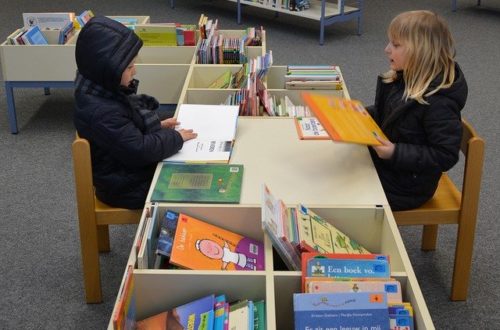I’ve written a lot about the problems with three-cueing approaches to teaching reading recently, but given that it’s a topic many people remain unfamiliar with, I thought it would be helpful to lay all the major issues out in one place.
Here is how the three-cueing approach (also popularly known as MSV) is supposed to work:
Students memorize a number of common “sight words”: short, high-frequency words such as are, can, we, and it. They also learn to focus on beginning letters so that they can use the initial sound in a word to help them identify unfamiliar terms.
The first books they use are repetitive readers that typically include one non-sight word per page/line of text; each page is accompanied by an illustration so that students can learn to use picture cues as well as first letters (and sometimes also last letters) to identify unknown words.
As they progress, children are instructed to ask themselves the following questions when identifying words via cues:
- Does the word [I plugged in] make sense?
- Does the word sound right?
- Does the word look right?”
The use of leveled readers and the focus on “just right” books ensure that the number of unfamiliar words—as well as the number of cues—a child encounters are limited to a manageable level. The idea is that new words learned from context this way will be stored in the child’s memory, adding to their “bank” of words and gradually allowing them to read more challenging texts.
In a more extreme version of the theory (based on Ken Goodman’s influential but staggeringly wrongheaded assertion that “reading is a psycholinguistic guessing game”), children may not even be expected to memorize non-sight words at all: the assumption is that virtually any unknown term can be figured out from context, and that the goal of reading instruction is effectively to help children become more accurate guessers.
To be fair, some balanced-literacy programs do contain a substantial phonics component. The problem is that although giving children multiple strategies for figuring out unknown words may intuitively seem like a good idea, cueing methods do not complement phonetic reading but rather contradict it by pulling children’s attention away from the specific sequence of letters in a word.
This approach also gives children easy options such as looking at pictures and guessing, which are understandably preferable to the hard work of decoding but result in dramatically different skill levels. So while children may identify many words correctly in the short term, giving the illusion of proficiency, they do not build the kind of foundation that will ultimately allow them to read at an advanced level.
To be very clear, there are situations in which the use of context clues is perfectly appropriate. For example, a child who phonetically decodes an irregularly pronounced word such as mosquito may be initially confused and need to use context to figure out what it is. That’s fine as long as the textual cues are used to supplement the phonetic process, not to replace it.
The problem occurs when external cues are used as a substitute for phonics in situations where words are decodable, or as an excuse to teach phonics poorly or haphazardly.
So that said, when you look closely at the assumptions on which three-cueing methods are based, things fall apart pretty quickly, and in a very serious way. Here’s why:
1) Sound-spelling relationships are not established
As cognitive scientists have known since the 1980s, strong readers are able to identify words effortlessly and efficiently because sound-spelling correspondences are wired together in their brains, allowing for automatic recall. (The formal term for this is orthographic mapping.) Skilled readers have not simply memorized what words look like; rather, their brains have recorded what words look-sound like and turned them into true “sight words” that are recognized immediately, allowing the reader to focus on meaning.
Children who learn to read by associating syllables and sounds need very few exposures to a word to learn it permanently. But in order for this to occur, they must be able to distinguish the individual sounds (phonemes) in a word and relate them to the letters and letter-combinations. The spelling-sound relationship involving all the phonemes in a word is the crucial component missing in the three-cueing approach.
Furthermore, children who focus only on beginning/ending letters when identifying unfamiliar words are unlikely to pay close enough attention to overall spellings to retain them as sight words (in the sense of words whose spellings are learned visually by rote), and thus they may not recognize them in other contexts. The whole point of three-cueing is that cues are used to substitute for sound-spelling relationships. It is illogical to expect that children taught to focus on only some letters in a word will be able to accurately assess whether a word “looks” right.
2) Speed
When it comes to proficient reading, speed is skill. For example, a student reading around 75 words per minute at the end of second grade is spending so much time and effort on word recognition and decoding that they will be unable to absorb the meaning. (In contrast, second graders reading upwards of 140 wpm, the 90th percentile, absorb text much more automatically.) The three-cueing approach, however, turns the process of identifying unfamiliar words into a cumbersome, time-consuming game of guess-and-check as students hunt elsewhere on the page for clues to their meanings and stop to ask them themselves whether they look right, sound right, etc. It’s not hard to imagine what happens to reading speed when a child has to stop and go through this process every few sentences.
Yes, students who learn to read phonetically may initially spend a lot of time sounding words out, but in that case, speed is a comparatively easy issue to resolve (even if it is challenging in absolute terms). In contrast, there is no way for three-cueing strategies to result in reading that is both faster and more accurate; a student may learn to plug in words more quickly, but there is a high probability that a number of those words will be wrong.
3) Pictures
Another enormous problem is that the three-cueing approach encourages children to focus on images rather than words—precisely what people who cannot read do. Very young children may come away thinking that words say what they say because of the pictures illustrating them, rather than because they consist of letters written in a particular sequence. Essentially, they may develop a faulty understanding of what reading is.
Furthermore, children who are accustomed to relying on pictures will encounter enormous difficulty when they begin to read books consisting of text alone.
4) Confusion between similar-looking words
When children are taught to focus on first and last letters, they learn that the letters in the middle of a word do not really matter and that it is unnecessary to pay them much attention. As a result, they are likely to confuse words with similar beginnings and endings but different middles. As texts become more challenging, these types of misreadings (e.g., resolve for revolve; differ for defer; inhabit for inhibit) have a progressively more detrimental effect on comprehension.
Interestingly, focusing on first and last letters is a stage that children typically go through when learning to read phonetically; however, three-cueing methods are essentially designed to keep them stuck there more or less indefinitely.
Alternately, students who “look for little words in big words” may guess based only on letters in the middle of a word and ignore the beginning and end.
5) Multiple words may make sense in context
In many instances, more than one word may make sense in context, and there is no guarantee a child will come up with the right one. For example, if the text reads, “One day, the old man said, ‘Let us have some turnip soup’” and a child does not know what a turnip is or has never seen the word, they might guess tomato because it begins with a “t” and the picture accompanying the text shows a man pulling up a plant. (How many kids can identify a tomato plant vs. a turnip plant?!)
Likewise, there is nothing in the three-cueing model to account for plug-ins that aren’t correct but also not wrong enough for a child to pick up on the error. For example, consider the sentence “Once during the war Washington decided it would be a good idea if his troops swore allegiance to the United States.” Stumbling over allegiance, a student might plug in a simpler, known term like again because it begins with an “a,” contains some of the same letters, and makes basic grammatical sense.
6) Misunderstanding context clues
The directive to rely on context clues to figure out unfamiliar words is based on the assumption that students will have correctly read and understood the context clues; however, that is not a reliable assumption. It is entirely possible—even probable—that readers will sometimes have difficulty recognizing, or understanding, more than one word per sentence or section of text. (Thanks to Mark Seidenberg for pointing this out.)
If the cues a student uses to determine an unfamiliar word are themselves faulty, correct identification of the word may be impossible and create a domino effect of misunderstandings.
7) Absence of context clues
Another major problem with three-cueing methods is that they are designed to get early elementary students reading on grade level; there is no apparent thought given to the issues that children taught to read this way may face years down the line.
In the early grades, the use of carefully selected leveled readers can allow teachers to ensure that students only encounter books in which unfamiliar words can be determined from context. In the real world, however, books many contain many challenging words that cannot be identified, or even guessed at, from other elements in the text.
For example, a student who has learned to read by relying on context clues and has poorly developed decoding skills will be at a complete loss when trying to understand, say, a tenth-grade chemistry textbook. There is no way to figure out specialized scientific or technical vocabulary terms such as isotope or oxidization from context unless one is already very familiar with them.
Likewise, a history book may be filled with references to proper names (including places) that are impenetrable to a student who cannot decode.
If teachers do not engage in direct instruction, students may not hear these words spoken aloud either and thus miss out on the opportunity to make the connection between speech and writing.
8) The self-monitoring problem
As a general rule, young children lack the metacognitive skills—that is, ability to think about their thinking—to monitor their own reading consistently and effectively. With guidance, they may be able to recognize their errors; when they are working independently (or in pairs), however, they may not be aware of them.
Even if they can think about the meaning, readers who do not have a strong sense of how written English works may not notice that a word they have plugged in is illogical. In extreme cases, they may even plug in the wrong part of speech without noticing a problem.
9) Limited vocabulary development
Research has shown that unlike children taught phonetically, first-graders taught via non-phonetic methods do not produce either nonsense words or real-but-unknown words when trying to read unfamiliar terms. Instead, children taught non-phonetically plug in only words that are already part of their vocabulary.
If a student cannot even recognize that a particular sequence of letters represents an unknown word, not only do they miss out on the opportunity to acquire new vocabulary, but they do not even have the chance to learn what they do not know. This is in turn makes self-monitoring even more difficult.
10) Eyes roaming around the page
The ability to read well, and at an appropriate speed, depends in large part on a reader’s ability to absorb entire lines of text, sequentially from left to right, whereas three-cueing methods encourage students to repeatedly move their eyes around the page. A student may read the first letter or two in a word, then immediately shift their eyes to a picture, or to another part of the sentence or paragraph.
Children who learn to read this way may develop difficulty reading words in a normal left-to-right sequence; instead, their eyes may dart erratically around the page, preventing them from obtaining a coherent understanding of a text.
This is not a problem that goes away on its own—in fact, I first got interested in how reading gets taught after observing it repeatedly in high-school aged students. As readings become more challenging and clues less obvious or absent, students who are unable to identify unfamiliar terms may scan the page randomly in a search for clues or stare into space in an attempt to pull an option from the recesses of their mind.
At a certain point, it morphs from a conscious process into an automatic reaction, and once that happens, it becomes extraordinarily difficult to remedy—even with intensive intervention.





